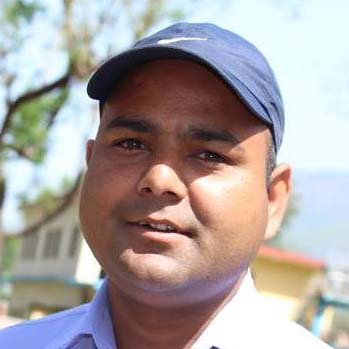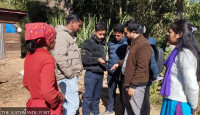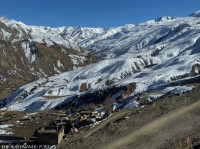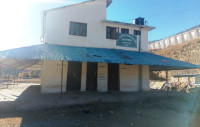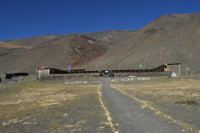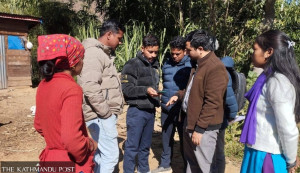Karnali Province
Risk is high, but returns are low for yarsagumba collectors
Thousands risk their lives each season, but traders say Chinese buyers call the shots on price. Also, overharvesting has worsened yields in recent years.
Krishna Prasad Gautam & Ramchandra Neupane
Though yarsagumba (Ophiocordyceps sinensis) fetches soaring prices in international markets, collectors in Nepal’s Karnali region have been struggling to find good prices for the prized caterpillar fungus. They are receiving no more than Rs1,000 per piece—and often much less—despite risking their lives to gather it in the highland meadows.
Bhiudal Budha, 54, of Khatyad Rural Municipality in Mugu district has been collecting yarsagumba for nearly 15 years. “I’ve built a two-storey house in Surkhet from yarsagumba earnings. But now, prices have dropped and yields are down,” he said. “Last year, we invested Rs50,000 to reach the pastures, and our family of four earned just over Rs120,000. Given the hardship and risk, we should have earned at least Rs300,000,” he complained.
Prem Bahadur Pun, 59, from ward 1 of Athbiskot Municipality in Rukum West echoed the same frustration. “My wife and I gathered just 170 pieces of yarsagumba last year. We sold 150 of them for Rs1,000 each and brought the rest home as gifts. It’s tough—we suffer in the cold, hike the perilous trails, and yet don’t even break even.”
Traders hike to the highland meadows to buy the precious fungus. They admit that prices at the collection sites remain low. “Although international demand is high, Chinese buyers dictate the market. We store yarsa until they arrive and decide the price. Since we buy at our own risk, we can’t offer more than Rs1,000 per piece,” said herbs trader Yagya Bahadur Budhthapa.
Parbal Lama, a trader from Chharka Tangsong in Dolpa, claims prices have declined. “We used to sell a kilo for Rs3.2 million before the Covid pandemic. In 2023, we sold yarsa at Rs2.7 million per kilo. Last year, it fetched just Rs2.2 million. And now it’s also harder to find top-grade yarsa,” he said.
One kilogram contains about 2,500 pieces, according to Lama, meaning even bulk sales fetch less now. Poor quality—especially immature yarsa—is contributing to falling prices.
The local people in the region are worried about the declining harvests in recent years. Narsingh Rokaya, chairman of Jagadulla Rural Municipality in Dolpa, highlighted the growing despair among the yarsa pickers. “Yarsa is the main livelihood for many. But falling yields and difficult terrain make it hard to sustain,” said Rokaya.
Surya Bahadur Budha of Tripurasundari Municipality has trekked to the highlands for the past three decades. “In 2002, a kilo sold for Rs60,000. In 2003, the price jumped to Rs150,000. That year, we collected three kilos and built a three-story house in Nepalgunj,” he recalls better times. But now, with less rainfall, he expects lower yields this season. “We trek across cliffs, risk altitude sickness and lightning—just to collect yarsa. But we cannot find yarsa like in the past.”
Collection officially began on May 18 in Dolpa, where 62 designated sites—including 41 community forests and 21 areas within Shey Phoksundo National Park—are open. Over 4,000 locals have already reached the pastures, said Division Forest Officer Mun Bahadur Rawat.
Mugamkarmarong Rural Municipality of Mugu district has also opened collection from May 26. The local government charges Rs2,000 for district residents and Rs 2,500 for outsiders. “Prices depend entirely on Chinese buyers,” said Chairperson Chhiring Kyapne Lama. “Some collectors couldn’t sell last year’s harvest due to poor rates.” Last year, Mugamkarmarong alone collected Rs6.95 million in revenue from 7,000 collectors.
Data from the Provincial Forest Directorate shows 214 kg of the caterpillar fungus was exported last year—down from 401 kg two years ago and 1,214 kg in 2018–19 before Covid halted operations. “Reduced rainfall, human encroachment, deforestation, and climate change are all impacting yields,” said botanist Kamal Sharma. “With limited farmland and no other livelihood options, people from the hills and mountains continue to risk their lives for yarsagumba,” he added. Overharvesting, he argues, has worsened the decline.
And the risks are mounting.
According to the Provincial Police Office, two collectors died in the past week—one from altitude sickness and another struck by lightning. “In the last three years, 39 collectors have died during yarsa collection in Karnali Provice,” said the office. “Last year alone, 14 people died in Mugu and Dolpa.”
Suresh Adhikari, Karnali province’s minister for Industry, Tourism, Forests and Environment, acknowledged the issues. “We’re working on a plan to make collection safer, more structured, and better integrated with market access,” he said. “Conservation and commercialisation of herbs like yarsa can boost local economies and create jobs.”
Yarsagumba is harvested before the monsoon season, between May and June, when tens of thousands of people swarm the Himalayan foothills in several districts of Sudurpaschim, Karnali and Gandaki provinces to collect the moth caterpillar fungus. Yarsagumba is the main source of income for many families in the area. It is found at altitudes between 3,540 to 5,500 metres.




 16.12°C Kathmandu
16.12°C Kathmandu